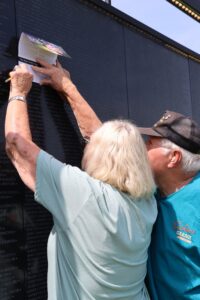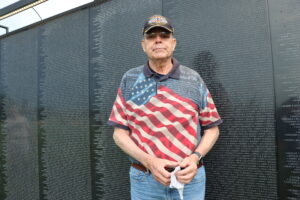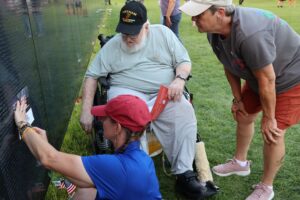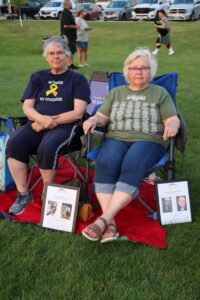It arrived in town with around 100 escorts, mostly on motorcycles, led by one carrying local Vietnam Veteran Dennis Otto, a two-time Purple Heart recipient who served in Vietnam from 1969 to 1971.
It closed with Vietnam Veterans Memorial Fund Site Manager
Rodney Gonsalves telling the last of 400 volunteer shifts that if asked, would they make the decision to come to Nevada, Iowa again, the answer would definitely be, “Yes.” From start to finish, despite occasional rain and gusts of wind, The Wall That Heals had a spectacular run in Nevada from its arrival on Aug. 5 to its final day, Sunday, Aug. 10.
During the Wall’s time in Nevada, according to Cathy Vincent, a Legion Auxiliary representative and member of Nevada’s Wall That Heals committee, more than 10,000 guests were greeted, helped, and comforted by those who came together to pay tribute to the more than 58,000 service men and women who died in the Vietnam War, to those who died later or suffered greatly from injuries of the War or the effects of Agent Orange, and to all those who served from the mid-1950s to the mid-1970s in a War that divided the nation and saw soldiers treated poorly upon their return.
Vietnam Veteran Neil Muhlenbruch of Dows came to Nevada to visit the wall with his wife, Kathie. He was doing a name rubbing of Jerry Ray Murphy. “He had less than one week left in the country (Vietnam) when he died,” Neil shared about Jerry.
Both Neil and Jerry were crew chiefs for the Army Aviation Cobra Platoon and roomed next to each other. “He was Cobra 8. I was Cobra 7,” Neil said, and recalled how he’d just spoken to Jerry before his friend died in an explosion while he was putting on a night recon light.
Neil served in Vietnam from September of 1965 to September of 1966, stationed at Vinh Long. He was shot on Feb. 4, 1966, and after 30 days in the hospital, he voluntarily chose to stay in Nam and finish his deployment. When he was asked about the treatment of Vietnam veterans back then and the respect they are receiving today, he commented, “It’s a long time past due.”

Vietnam veteran David Smith of Waukee came to the wall with his friend, Nancy Vaught. He walked to the panels that included the names of those who perished in the early 1970s, and he was overcome with emotion, pulling a handkerchief out of his pocket to wipe away tears. “These panels (three of them) have the names of all the guys who died when I was in the country,” he said. “That’s a lot.”

David, who was in Nam in 1971 and 1972, said he made a previous trip years ago to the Wall in Washington, D.C., around Father’s Day, and said there were notes along the wall from children of the Vietnam Vets. “I’ll never forget one of the notes,” he said, his voice cracking from emotion. “It read, ‘Daddy, they say I look just like you.’”
Nikki Arel, who joined Rodney Gonsalves as the other staff person on site for The Wall That Heals, was spending time giving tours to Wall visitors or helping people find names on the Wall. As a Cadre for The Wall That Heals, Nikki also had her own unbelievable story to tell.
She was just 10 years old on a family vacation in Washington, DC, when she visited the Vietnam Memorial Wall and spent her vacation allowance on a bracelet from a vendor selling bracelets with the names of veterans who were MIA. “I decided to pick one of someone from New York (which was her home state at the time), and who was in the Navy (like her dad), and whose date of being lost matched the time when my dad served.” The name on her bracelet was Richard M. Mancini.
She wore the bracelet always from that time on, and 19 years later, as a 29-year-old attending a friend’s wedding in Albany, NY, she was in her hotel room when a teaser for the evening news came on about a Vietnam Veteran’s remains being found. “I looked up, and it was his name, Richard M. Mancini, on the screen.”
Between the festivities of the weekend, she was making calls, trying to locate Richard’s family, leaving messages for Mancinis who lived in the area.
And it worked.
As she was preparing to leave the motel that weekend, she got a call from Rick Mancini, Richard’s son, who was heading to Hawaii to pick up his dad’s remains and invited Nikki to a memorial service two weeks later in Amsterdam, NY. At the memorial service, she gave the family Richard’s bracelet. It was the first time it had come off her arm since she was 10. Nikki remains close to the Mancini family today.


She loves to hear other people’s stories as they come to the Wall, and she notes that the reason most visitors come to the Wall is to pay respect. “A lot of those who were not alive during the Vietnam era, they really don’t understand how Vietnam veterans were treated. They can’t fathom it. And I love that they visit the Mobile Education Center (which travels with the Wall) and spend time learning. That’s one of the most beautiful things, that we’re able to teach and raise a little consciousness and awareness about the impact of war and what it means to serve your country.”
On Saturday evening of the Wall’s visit in Nevada, there was a special service to recognize those who’ve died or suffered from the effects of Agent Orange, a herbicide and defoliant used by the United States military during the Vietnam War. Agent Orange helped remove vegetation to deny the enemy both cover and food.
But later, the effects of Agent Orange on the soldiers who were using it, had devastating consequences to their long-term health.
Connie Cook and Carol Baxter, both of Ames, displayed framed pictures of their departed husbands next to them as they attended the Agent Orange ceremony on the evening of Aug. 9, when the wall was illuminated with orange lights.
Ronald Baxter, who passed away in July 2020, was a member of what his wife said was called the “Brown Water Navy,” which supplied troops up and down the De Neg River. His exposure to Agent Orange caused him to suffer neuropathy in both legs.
Jack Cook was in the Army and served in three spots near the jungles, where they used Agent Orange. His exposure caused Parkinson’s Disease. Jack passed away in January of 2023.
Last year, Connie and Carol traveled to Washington, D.C., for a special Agent Orange ceremony in June. “It was a wonderful experience. We laid white roses on the wall,” Carol said. Many white roses were laid at The Wall That Heals in Nevada. “I’m glad to be here and glad to honor him,” Carol said. And she noted that her husband never regretted his service to the country. “He always said he’d do it all over again.”
Nevada resident Kris Dugger, who retired from the Iowa Army National Guard in January of this year, after 32 years of service, was asked to be part of Nevada’s Wall That Heals committee in 2024. “My role was to plan and organize the Escort (to bring the Wall to town),” Kris said.
He was able to start that Escort anywhere within an hour of Nevada. He chose the Iowa Veterans Home, where half of the current residents are Vietnam Veterans. Kris said it was the ideal location to assemble, stage and depart the Escort toward Nevada, via the historic Lincoln Highway.
“Onlookers showed their patriotism and support along the route from Marshalltown to State Center, to Colo, near Fernald, and into Nevada. A detour north from Colo was needed due to railroad bridge clearance,” he explained. The Wall tractor/trailer is 13 feet, 6 inches tall, and the underpass between Nevada and Colo is 12 feet 6 inches in height.
“It was a great honor to be part of this effort, to see this great parade assemble, drive among the beautiful farm fields of Central Iowa and enter our town with outstanding support from our local citizens and entire community,” Kris said. “Our Vietnam Veterans deserve our respect and appreciation, and The Wall coming to town was a great way to show this love to this generation of servicemen and servicewomen.”
Nevada Public Safety Director and Police Chief Chris Brandes, a member of the Iowa National Guard since 2003 who deployed to Iraq during Operation Iraqi Freedom, said he was honored to give closing remarks on the last day The Wall That Heals was in Nevada. He noted how special it was during the Wall’s time in Nevada to see veterans and members of the military from many other wars and conflicts and times of service coming to pay tribute to Vietnam veterans.
His remarks were followed by closing thoughts from Cathy Vincent, who acknowledged all of the people, volunteers, and businesses that made generous contributions during The Wall’s time in Nevada. And she paid a final tribute to those at the heart of it all. “To all Vietnam Vets, we see you, we applaud you, and we thank you for your service.”
–Written by Marlys Barker, City of Nevada





